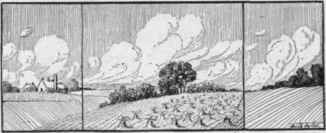Horsetail Family (Equisetaceae) - Common Or Field Horsetail (Equisetum Arvense L.) - Plate III (To Face Page 12)
Description
This section is from the book "Principal Poisonous Plants Of Canada", by Faith Fyles. Also available from Amazon: Principal poisonous plants of Canada.
This section is from the "" book, by .
Horsetail Family (Equisetaceae) - Common Or Field Horsetail (Equisetum Arvense L.) - Plate III (To Face Page 12)
Common Names
Among the popular names of horsetail are the following, which are typical and descriptive: pine-top, meadow-pine, scouring rush, bottle brush, snake-pipes, jointed rush, and cornfield horsetail.

Field Horse-tail a=Sterile stem, b = Fertile
Description
The horsetails or scouring rushes are a group of perennial plants intermediate between the ferns and club-mosses. Like the ferns they possess a more or less branching, creeping rootstock which persists from year to year and sends out new shoots each year. The rootstock of the field horsetail develops also short tuber-like branches, which act as storehouses of reserve material. As in some of the ferns, the rootstock sends up two distinct kinds of leaf-shoots, a fertile and a sterile shoot, each of which is distinctly jointed and hollow. The fertile stems, which bear the spores, or reproductive bodies, appear early in May, before the sterile or vegetative shoots have yet unfolded. They are from four to ten inches high, usually unbranched, light-brown, with darker brown, scale-like leaves arranged in circles at each joint or node. At the apex of each fertile stem is a group of sporophylls known as the cone, from which the spores fall to the ground and produce new plants. The spores are round, and each is furnished with two spiral bands or elaters (so attached as to appear to be four) which assist in its dispersal. The sterile stems are from four to twenty inches high, bright green, grooved, with angled, solid branches.
Distribution
The field horsetail is native to Canada, and is found in gravelly or sandy soil from Newfoundland to Alaska.
Poisonous Properties
The harmfulness of field horsetail has for many years been the subject of much discussion and difference of opinion, but in Canada it was found to be the cause of much loss (see Dominion Experimental Farms Reports 1910, p. 200, 1912, p. 210-11.) The toxic principle has not been determined.
Animals Affected
Horses suffer most from eating this weed in the hay, particularly young horses. It is also known to be injurious to sheep, but there is a difference of opinion as to its effect upon cattle. The weed does not appear to be as poisonous when eaten in a green state. This may be due to the laxative properties of other fresh food eaten at the same time, or to the fact that the plant is not as common in pastures as in meadows and, in consequence, is not eaten to the same extent. Animals grazing in pastures containing horsetail, should be watched and removed from the field of danger at the first symptoms of poisoning.
Symptoms
The first general symptoms are a certain excitement, unthriftiness, diarrhoea, good appetite; later, staggering gait, partial loss of motive power, craving for the weed, pulse accelerated, respiration difficult, sometimes convulsions and death or a state of unconsciousness and coma. Sometimes the attack is very acute, death occurring in a few hours; usually, however, the disease lasts from a few days to several weeks.
Remedy and Means of Control: The first and most important thing to be done is to change the food. Remove all hay and bedding containing equisetum. Administer a purgative, as raw linseed oil or aloes, to remove any undigested portion of the plant, and give stimulants, camphor, or powdered nux vomica with grain feed three times a day. Blisters along the spine are beneficial (Friedberger and Frohner). In severe cases, slings should be used to support the animal before it loses the power to stand. If this treatment is begun in time, the animals will recover in practically all cases.
This weed may be held in control by draining, enriching, and cultivating the ground. It thrives best in sandy or gravelly soil that is wet in the spring and early summer, or where the underlying water is not far from the surface of the soil. Good drainage and good cultivation will eventually exterminate it as, although the rootstocks lie lower than the depth of ordinary cultivation, they will starve if the green food-producing shoots are kept cut.

Continue to:


